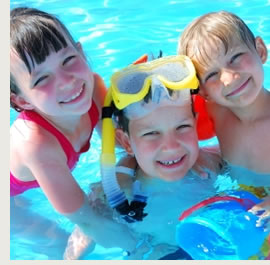|
|
||||
|
||||
| Don't be complacent about water safety | ||||
| Make sure the whole family is swim safe this summer | ||||
 It's that time of year again when the weather's starting to heat up, summer holidays are around the corner and we're all looking forward to summer on the beach and by the pool. It's that time of year again when the weather's starting to heat up, summer holidays are around the corner and we're all looking forward to summer on the beach and by the pool.There has been an alarming rise in the number of very young Australians drowning over the last year and authorities are at a loss to explain why. According to the latest drowning statistics, 31 babies and toddlers under the age of five drowned in waterways, pools and bathtubs in Australia over the last year. That's a 50 per cent increase on the previous 12 months. Simon Santow of the ABC recently reported that for the Royal Life Saving Society the annual drowning figures are "a sobering reminder about the risks Australians take in and around water". In his recent interview with Simon Santow, Justin Scarr, CEO of the Royal Life Saving Society said that people assume that the majority of drownings happen in a beach location and that's not the case. "We see 34 per cent of drowning deaths happening in inland waterways, so our lakes, rivers and dams are largely unpatrolled and we're seeing large numbers of drownings". For reasons the authorities cannot fathom this represents a 50% increase from the previous year, although with pool fencing legislation and other measures including a compulsory swimming register introduced this year in NSW, Scarr says they are hoping that numbers of drownings will go back to the previous trend which was a steady drop over the last ten years. However, Scarr says that it's primarily up to pool owners to ensure that they understand the responsibilities of adult supervision, educate the family members to make sure they're also aware of the dangers of propping pool gates open and allowing access for the very young children into those backyard swimming pools. In the summertime it's very easy to get a little complacent. Hot snoozy days out on the beach or in the back garden near the pool, parties or guests, lots of distractions. But even the tiniest lapse in vigilance can be fatal, especially when it comes to small children who are not yet proficient or confident swimmers. Toddlers and young children are most at risk from drowning and near drowning incidents: 30 per cent of drowning cases were children under four years old, who made up 63 per cent of drowning incidents in swimming pools. There's no substitute for parent vigilance and of course no child should be left unattended in any pool or sea, but water confidence and awareness of the dangers of water can go a long way to preventing accidents and drownings in backyard pools and the sea. Do you know the signs of drowning? It's also well documented that toddlers simply let themselves drown. So it's imperative that all family members and friends know what to look out for in terms of knowing when someone is in danger. Readers Digest recently published the following 8 Quiet Signs of Someone Drowning:
Most preschools and child care services usually have some sort of program or lessons on water safety for young children. It goes hand in hand in Australia with road safety and stranger danger. If your centre doesn't have a scheduled program or lessons in water safety – put that in the suggestion box. It's easy to organize with one of the local representatives of Austswim, Surf Life Saving or even a local swimming instructor. Top Tips for Pool & Beach Safety
Go to www.austswim.com.au to find your nearest teacher or aquatic facility. For more information on swim safety go to: www.dsr.nsw.gov.au/swimandsurvive/ |
|
|||||||||
